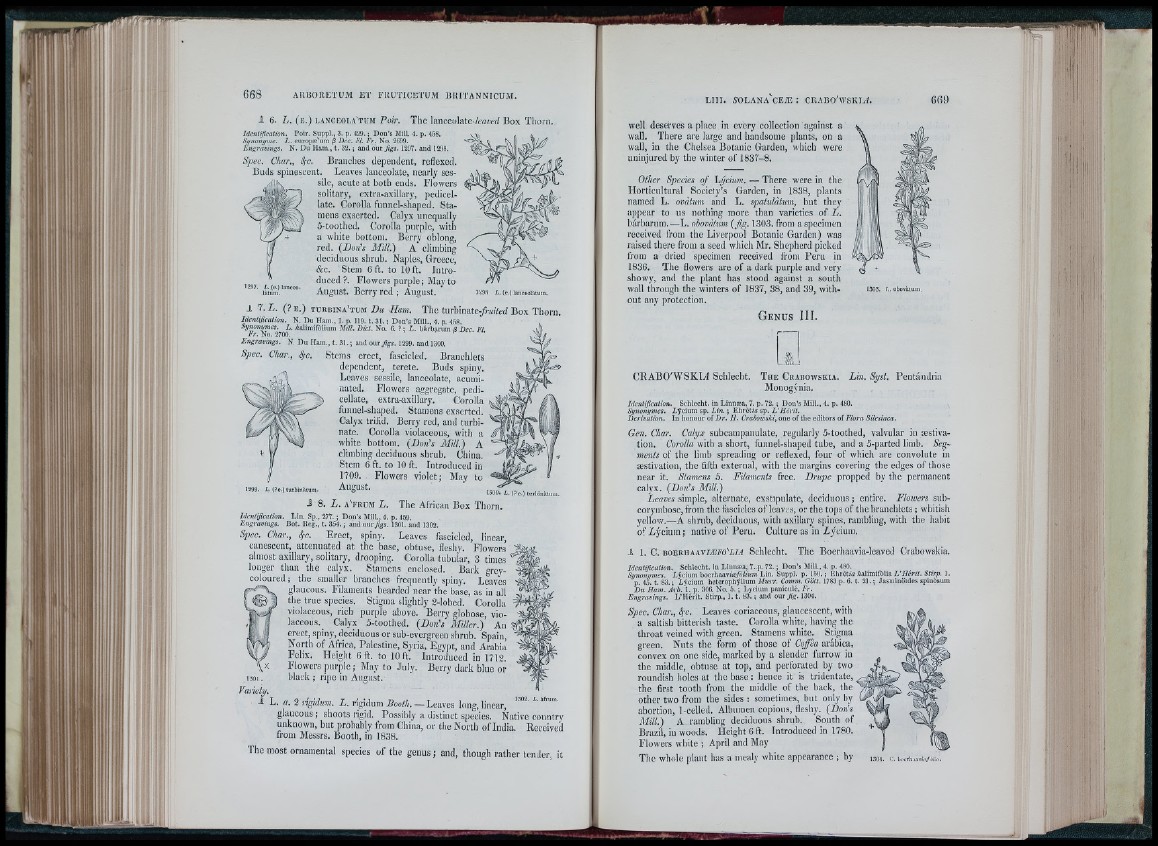
1 (). L. (e .) la n c ro la 'tum Poir. The lanceolateZc-rtw'Z Box Thorn.
Identification. Poir. Suppl., 3. p. 429. ; Don’s Mill. 4. p. 458.
Synonyme. L . europæ'um /3 Dec. l-i. Fr. No. 2G99.
¡engravings. N. Du Hiun., t. 32. ; and o u r /g s . 1297. and 1298.
Spec. Char., cÿc. Branches dependent, reflexed.
Buds spinescent. Lcaves lanceolate, nearly sessile,
acute at both ends. Flowers
solitary, extra-axillary, pedicellate.
Corolla funnel-shaped. Stamens
exserted. Calyx unequally
5-toothed. Corolla purple, with
a white bottom. Bcrry oblong,
red. {Doris Mill.) A climbing
deciduous shrub. Naples, Greece,
&c. Stem Gft. to 10 ft. Introduced?.
Flowers purple; May to
August. Berry red ; August. I '/o s l . (e.) iancoolàiuin.
1 7. L. (? E .) TUK n iN A'TiiM Du Ham. The tmhmate-fruHed Box Thorn.
IdctUification. N. Du Ham., 1. p. 119. t. 31. : Don’s Mill., 4. p. 458.
F f r S f f i im " No-' 6.I-, L . Mibarum ^ Dec. Fl.
N. Du Ham., t. 3 !.; and o u r /g s . 1299. and 1300.
Spec. Char., S/c. Steins erect, fascicled. Branchlets
dependent, terete. Buds spiny.
Leaves sessile, lanceolate, acuminated.
Flowers aggregate, pedicellate,
extra-axillary. Corolla
funnel-shaped. Stamens exserted.
Calyx trifid. Berry red, and turbinate.
Corolla violaceous, with a
white bottom. {Doris Mill.) A
climbing deciduous shrub. China.
Stem 6 ft. to 10 ft. Introduced in
1709. Flowers violet; May to
1299. L. (?e.) tu rb ln à ium . AugUSt.
A 8 . L . a ' f r u m L.
1300. ft. (?e.)t«rbin.>iluii
The African Box Thorn.
Identification. Lin. Sp., 277.; Don’s Mill., 4. p. 459.
Engravings. Bot. Reg., t. 354.; and awTjigs. 1301. and 1302.
Spec. Char., f r . Erect, spiny. Leaves fascicled, linear,
canescent, attenuated at the base, obtii.se, fleshy. Flowers
almost axillary, solitary, drooping. Corolla tnbuiar, 3 times
longer than the calyx. Stamens enclosed. Bark grey-
coloured ; the smaller branches frequently spiny. Leaves
glaucous. Filaments bearded near the base, as in all
the true species. Stigma slightly 2-lobed. Corolla
violaceous, rich purple above. Berry globose, violaceous.
Calyx 5-toothed. {Doris Miller.) An
erect, spiny, deciduous or sub-evergreen shrub. Spain,
North of Africa, Palestine, Syria, Egypt, and Arabia
Felix. Height 6 ft. to 10 ft. Introduced in 1712.
Flowers purple ; May to July. Bcrry dark blue or
black ; ripe in August.
Variety.
-t L. a. 2 rigidum. L. rigidum rtoo¿/¡. — Leaves long, linear,
1302. ft. àfiuin.
glaucous ; shoots rigid. Possibly a distinct species. Native counli’v
unknown, but probably from China, or the North of India. Received
from Messrs. Booth, in 1838.
The most ornamental species o f the genus; and, though rather tender, it
well deserves a place in every collection against a
wall. There are large and handsome plants, on a
wall, in the Chelsea Botanic Garden, which were
uninjured by the winter of 1837-8.
Other Species of Lycium. — There were in the
Horticultural Society’s Garden, in 1838, plants
named L. ovàtum and L. spatulàtum, but they
appear to us nothing more than varieties of L.
bárbarum.—L. obovàtum {fig. 1303. from a specimen
received from the Liverpool Botanic (jarden) was
raised there from a seed which Mr. Shepherd picked
from a dried specimen received from Peru in
1836. The flowers are of a dark purple and very
showy, and the plant has stood against a south
wall through the winters of 1837, 38, and 39, without
any protection.
G e n u s III.
1.303. ft.oUovàtuiT)
C FA B O 'W SK U Schlecht. T he C r a b o w s k i a .
Monogynia.
Lin. Syst. Pentandna
Identification. Schlecht. in Linnæa, 7. p. 72. ; Don’s Mill., 4. p. 480.
Synonymes. Jvÿciiim sp. Lin. ; Eh rè tia sp. L 'H é r it.
Derivation. In honour of D r . H. Crabowski, one of the editors of Flora Silesiaca.
Gen. Char. Calyx subcampanulate, regularly 5-toothed, valvular in æstivation.
Corolla with a short, funnel-shaped tube, and a 5-parted limb. Segments
of the limb spreading or reflexed, four of which are convolute in
æstivation, the fifth external, with the margins covering the edges of those
near it. Stamens 5. Filaments free. Drupe propped by the permanent
calyx. {Doris Mill.)
Leaves simple, alternate, exstipulate, deciduous ; entire. Flowers sub-
corymbose, from the fascicles of leaves, or the tops of the branchlets ; whitish
yellow.—A shrub, deciduous, with axillary spines, rambling, with the habit
ofjZyciuin; native of Peru. Culture as in iy c ium .
1 1. C. b o e r i i a a v /Æ F O 'z - j .^ Schlecht. The Boerhaavia-leaved Ciabowskia.
Identification, Schlecht.otiuecia. lu in Linnæa, 7.«.. p. 72.n.. ; Don’s ¡
MMiillll..,, 44,, pp.. 448800..
Svnonvmes. Lÿcium boerhaavìa/òì?«?« I>in. Suppl. . I. . 150.;.
E h r è tìa /jalimifblia Z,’//ér?ï. Stirp. 1.
p. 45. t. 83. ; Lôciuin heterophÿllum Muir. Comm. Gott. 1783 p. G. t. 21, ; Jasminoldes spmÒBum
D u Ham. Arb. 'l. p. 306. No. 5. ; Lycium paniculé, Fr.
L ’H érit. Stirp., 1 .1. 83. ; and oar fig. 1304.
Sjiec. Char., f r . Leaves coriaceous, glaucescent, with
a saltish bitterish taste. Corolla white, having the
throat veined with green. Stamens white. Stigma
green. Nuts the form of those of Coffea arábica,
convex on one side, marked by a slender furrow in
the middle, obtuse at top, and perforated by two
roundish holes at the b ase; hence it is tridentate,
the first tooth from the middle of the back, the
other two from the sides ; sometimes, but only by
abortion, 1 -celled. Albumen copious, fleshy. {Doris
Mill.) A rambling deciduous shrub. South of
Brazil, in woods. Height 0 ft. Introduced In 1780.
Flowers white ; April and May
The whole plant has a mealy whitc appearance ; by 1301. C. U'crh.iaviV/W.'n
I li ;i